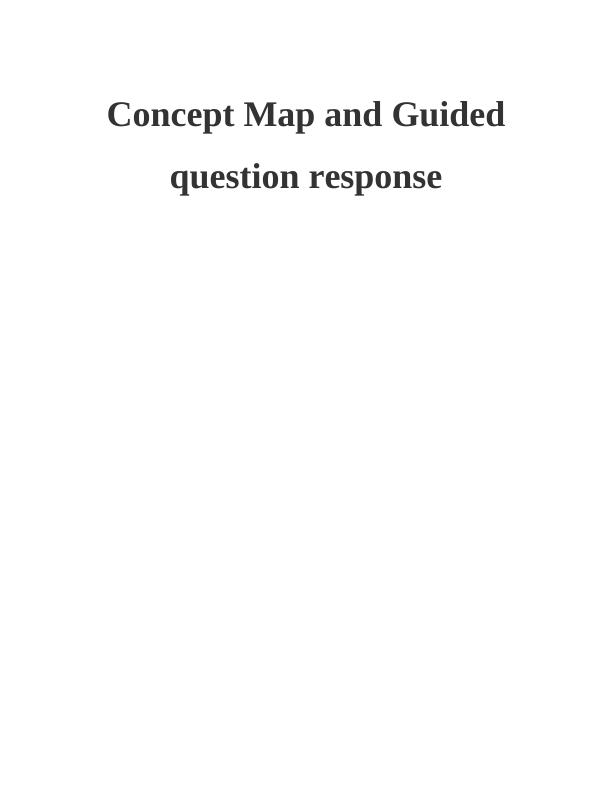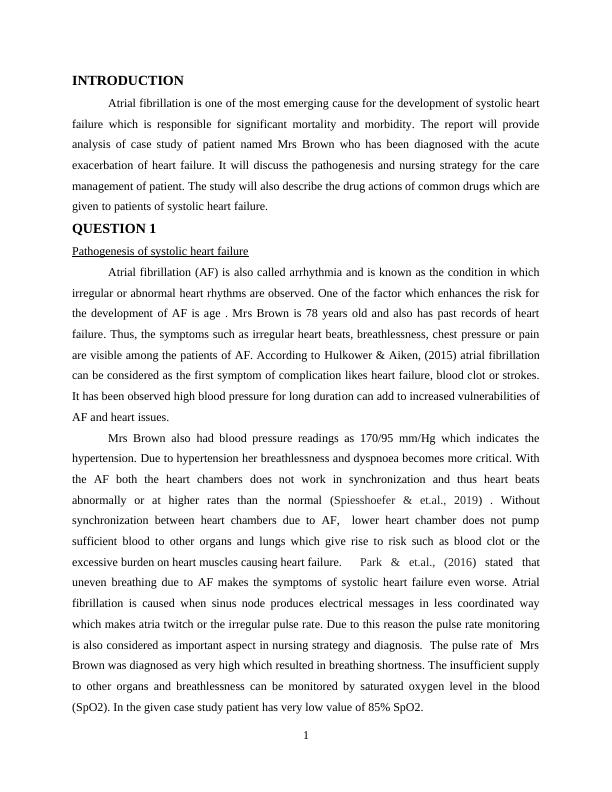Pathogenesis of Systolic Heart Failure - PDF
Added on 2021-02-19
12 Pages1881 Words16 Views
Concept Map and Guidedquestion response

TABLE OF CONTENTINTRODUCTION...........................................................................................................................1QUESTION 1...................................................................................................................................1Pathogenesis of systolic heart failure...........................................................................................1QUESTION 2 ..................................................................................................................................3Priority nursing strategy for patient.............................................................................................3QUESTION 3 ..................................................................................................................................4Pharmacological actions of Lasix and GTN ...............................................................................4.....................................................................................................................................................4CONCLUSION ...............................................................................................................................4REFERENCES................................................................................................................................5

INTRODUCTIONAtrial fibrillation is one of the most emerging cause for the development of systolic heartfailure which is responsible for significant mortality and morbidity. The report will provideanalysis of case study of patient named Mrs Brown who has been diagnosed with the acuteexacerbation of heart failure. It will discuss the pathogenesis and nursing strategy for the caremanagement of patient. The study will also describe the drug actions of common drugs which aregiven to patients of systolic heart failure. QUESTION 1Pathogenesis of systolic heart failureAtrial fibrillation (AF) is also called arrhythmia and is known as the condition in whichirregular or abnormal heart rhythms are observed. One of the factor which enhances the risk forthe development of AF is age . Mrs Brown is 78 years old and also has past records of heartfailure. Thus, the symptoms such as irregular heart beats, breathlessness, chest pressure or painare visible among the patients of AF. According to Hulkower & Aiken, (2015) atrial fibrillationcan be considered as the first symptom of complication likes heart failure, blood clot or strokes.It has been observed high blood pressure for long duration can add to increased vulnerabilities ofAF and heart issues. Mrs Brown also had blood pressure readings as 170/95 mm/Hg which indicates thehypertension. Due to hypertension her breathlessness and dyspnoea becomes more critical. Withthe AF both the heart chambers does not work in synchronization and thus heart beatsabnormally or at higher rates than the normal (Spiesshoefer & et.al., 2019) . Withoutsynchronization between heart chambers due to AF, lower heart chamber does not pumpsufficient blood to other organs and lungs which give rise to risk such as blood clot or theexcessive burden on heart muscles causing heart failure.Park & et.al., (2016) stated thatuneven breathing due to AF makes the symptoms of systolic heart failure even worse. Atrialfibrillation is caused when sinus node produces electrical messages in less coordinated waywhich makes atria twitch or the irregular pulse rate. Due to this reason the pulse rate monitoringis also considered as important aspect in nursing strategy and diagnosis. The pulse rate of MrsBrown was diagnosed as very high which resulted in breathing shortness. The insufficient supplyto other organs and breathlessness can be monitored by saturated oxygen level in the blood(SpO2). In the given case study patient has very low value of 85% SpO2. 1

(Source: Verma, Kalman and Callans, 2017)As per Bhat & Tang, (2019) AF is perceived as the major contributor in exacerbation ofthe systolic heart failure because fast beating of heart make it hard to properly fill and pumpsufficient blood. As a result of this blood back up in pulmonary veins and lungs are filled withfluid. This development of fluid in lungs causes breathing shortness and lungs. In the assessment of Mrs Brown bilateral basal cracks were observed which clearlyshowed that lungs are filled with the fluids and thus AF serve as strong basis for the progressionor indication of heart failure. Systolic heart failure is also known as the heart failure with reducedejection fraction (HfrEF). The increased resting heart rate due to AF reduces cardiac output andventricular filling. The cardiac output reduction due to AF enhances the endothelin and plasmaepinephrine which augment the neurohormonal vasoconstrictor excess (Torres & et.al., 2015).This is observed in heart failure. The annular enlargement of functional mitral is evident amongpatients with heart failure history. It has been also observed that in full-blown versiontachycardia associated cardiomyopathy caused by AF ventricular rate become rapid andreversible. 2Illustration 1: Pathogenesis of systolic heart failure due to AF

End of preview
Want to access all the pages? Upload your documents or become a member.
Related Documents
Concept Map and Guided question responselg...
|1
|306
|83
Clinical Manifestation of Diseaselg...
|11
|2377
|23
Case study of chronic systolic heart failure of a diabetic female studentlg...
|10
|2559
|207
Case Study on Pathogenesis of Clinical Manifestations, Nursing Strategies and Mechanism of Two Drugs for Heart Failure Patientlg...
|9
|2179
|269
Assignment On The Respiratorylg...
|9
|2323
|16
Systolic Heart Disease: Pathogenesis, Nursing Strategies, and Drug Mechanism of Actionlg...
|8
|1920
|155